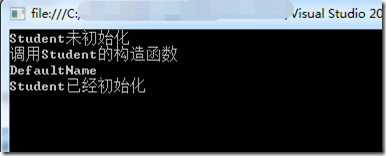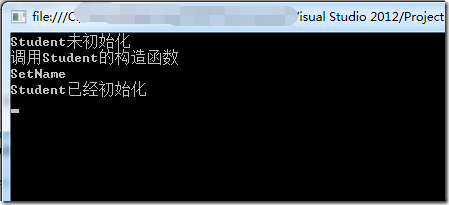1. 概述
我们创建某一个对象需要很大的消耗,而这个对象在运行过程中又不一定用到,为了避免每次运行都创建该对象,这时候延迟初始化(也叫延迟实例化)就出场了。延迟初始化出现于.NET 4.0,主要用于提高性能,避免浪费计算,并减少程序内存要求。也可以称为,按需加载。
2. 基本语法
Lazy<T> xx = new Lazy<T>();//xx代表变量名
3. 举例实现
首先创建一个Student类,代码如下:

 代码using System;
using System.Collections.Generic;
using System.Linq;
using System.Text;
using System.Threading.Tasks;
namespace LazyTest
{
class Student
{
public Student()
{
this.Name = "DefaultName";
Console.WriteLine("调用Student的构造函数");
}
public string Name { get; set; }
}
}
代码using System;
using System.Collections.Generic;
using System.Linq;
using System.Text;
using System.Threading.Tasks;
namespace LazyTest
{
class Student
{
public Student()
{
this.Name = "DefaultName";
Console.WriteLine("调用Student的构造函数");
}
public string Name { get; set; }
}
}

 代码using System;
using System.Collections.Generic;
using System.Linq;
using System.Text;
using System.Threading.Tasks;
namespace LazyTest
{
class Program
{
static void Main(string[] args)
{
Lazy<Student> student = new Lazy<Student>();
if (!student.IsValueCreated)
{
Console.WriteLine("Student未初始化");
}
Console.WriteLine(student.Value.Name);
if (student.IsValueCreated)
{
Console.WriteLine("Student已经初始化");
}
Console.ReadKey();
}
}
}
代码using System;
using System.Collections.Generic;
using System.Linq;
using System.Text;
using System.Threading.Tasks;
namespace LazyTest
{
class Program
{
static void Main(string[] args)
{
Lazy<Student> student = new Lazy<Student>();
if (!student.IsValueCreated)
{
Console.WriteLine("Student未初始化");
}
Console.WriteLine(student.Value.Name);
if (student.IsValueCreated)
{
Console.WriteLine("Student已经初始化");
}
Console.ReadKey();
}
}
}
设置断点调试后发现,在new完之后,student的IsValueCreated的值是false,value的值是null

接着往下走,调用到Name属性时,student的IsValueCreated的值是true,value的值已经不为null了


结果可以看出,Student是在输出Name属性才进行初始化的,也就是在第一次使用时才会去初始化,这样就可以达到减少消耗的目的。
这个例子很简单,也是Lazy<T>最基本的使用方式。我们还可以使用 Lazy<T> 的重载函数 Lazy<T> (Func<T>) 传入一个带返回值的委托来设置延迟初始化对象的属性值。

 代码using System;
using System.Collections.Generic;
using System.Linq;
using System.Text;
using System.Threading.Tasks;
namespace LazyTest
{
class Program
{
static void Main(string[] args)
{
Lazy<Student> student = new Lazy<Student>(() => new Student { Name = "SetName" });
if (!student.IsValueCreated)
{
Console.WriteLine("Student未初始化");
}
Console.WriteLine(student.Value.Name);
if (student.IsValueCreated)
{
Console.WriteLine("Student已经初始化");
}
Console.ReadKey();
}
}
}
代码using System;
using System.Collections.Generic;
using System.Linq;
using System.Text;
using System.Threading.Tasks;
namespace LazyTest
{
class Program
{
static void Main(string[] args)
{
Lazy<Student> student = new Lazy<Student>(() => new Student { Name = "SetName" });
if (!student.IsValueCreated)
{
Console.WriteLine("Student未初始化");
}
Console.WriteLine(student.Value.Name);
if (student.IsValueCreated)
{
Console.WriteLine("Student已经初始化");
}
Console.ReadKey();
}
}
}

注:Lazy<T> 对象初始化默认是线程安全的,在多线程环境下,第一个访问 Lazy<T> 对象的 Value 属性的线程将初始化 Lazy<T> 对象,以后访问的线程都将使用第一次初始化的数据。
4. 应用场景
有一个对象的创建开销很大,而程序可能不会使用它。例如,假定您的程序在启动时加载若干个对象实例,但只有一些对象实例需要立即执行。通过将不必要的对象的初始化延迟到已创建必要的对象之后,可以提高程序的启动性能。
代码
代码



代码




【推荐】国内首个AI IDE,深度理解中文开发场景,立即下载体验Trae
【推荐】编程新体验,更懂你的AI,立即体验豆包MarsCode编程助手
【推荐】抖音旗下AI助手豆包,你的智能百科全书,全免费不限次数
【推荐】轻量又高性能的 SSH 工具 IShell:AI 加持,快人一步
· AI与.NET技术实操系列:向量存储与相似性搜索在 .NET 中的实现
· 基于Microsoft.Extensions.AI核心库实现RAG应用
· Linux系列:如何用heaptrack跟踪.NET程序的非托管内存泄露
· 开发者必知的日志记录最佳实践
· SQL Server 2025 AI相关能力初探
· winform 绘制太阳,地球,月球 运作规律
· 震惊!C++程序真的从main开始吗?99%的程序员都答错了
· AI与.NET技术实操系列(五):向量存储与相似性搜索在 .NET 中的实现
· 【硬核科普】Trae如何「偷看」你的代码?零基础破解AI编程运行原理
· 超详细:普通电脑也行Windows部署deepseek R1训练数据并当服务器共享给他人
2017-12-14 C# 匿名类与匿名对象的用法